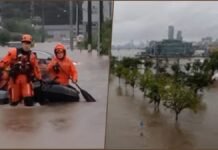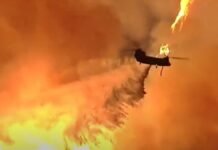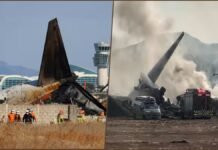
Key Points:
- Death Toll Rises: At least 18 people have died, and 19 others are injured as wildfires devastate South Korea’s southeastern regions.
- Massive Evacuations: Over 23,000 residents displaced, with historic sites and prisons evacuated.
- Government Response: Acting President Han Duck-soo declares a full-scale national emergency, with over 9,000 personnel deployed to combat the blazes.
- Cultural Loss: A 1,300-year-old Buddhist temple was destroyed, and UNESCO heritage sites are under threat.
Seoul: South Korea is grappling with one of its deadliest wildfire outbreaks in recent history. The fires, fueled by dry weather and strong winds, have ravaged southeastern regions since March 21, killing at least 18 people and injuring 19 others. Thousands of residents have been forced to flee their homes as the flames continue to spread across more than 43,000 acres of land.
Unprecedented Damage and Evacuations
The wildfires have caused “unprecedented damage,” according to Acting President Han Duck-soo, who has declared a full-scale national emergency. Over 23,000 people have been evacuated from affected areas, including Andong City, Uiseong County, Sancheong County, and Ulsan. Temporary shelters such as schools and gyms have been set up to house displaced residents.
The fires have destroyed hundreds of structures, including Gounsa Temple a Buddhist site built in the 7th century. While some national treasures were saved before the fire reached the temple’s wooden buildings, the loss is a significant cultural blow. UNESCO World Heritage sites like Hahoe Folk Village and Byeongsan Confucian Academy are also under threat.
In an unprecedented move, authorities evacuated more than 2,600 inmates from Cheongsong Prison and another 800 from Andong Prison as flames approached.
Massive Firefighting Efforts
Nearly 9,000 firefighters, supported by 130 helicopters and hundreds of vehicles, have been deployed to battle the wildfires. However, efforts have been hampered by shifting wind patterns of up to 25 meters per second and ongoing dry weather conditions. Overnight operations were partially suspended due to safety concerns.
Despite these challenges, officials report that some fires are now partially contained. Rainfall expected later this week may aid firefighting efforts.
Investigations into Causes
Authorities suspect human error may have sparked several of the blazes. Possible causes include sparks from welding work and the use of fire while clearing overgrown grass in family tombs. The government has announced stricter regulations on fire-related activities during the dry season to prevent future incidents.
Government Response and Support
The South Korean government has raised its wildfire crisis alert to the highest level. Emergency funds totaling KRW 2.6 billion (approximately $1.26 million) have been allocated for disaster relief efforts. Major corporations like Hyundai Motor Group and LG Group are also contributing financial aid and resources.
Acting President Han has vowed to provide comprehensive support for affected residents and urged public vigilance as dry spring weather persists. “We must concentrate all our capabilities to put out these fires,” he said in a televised address.
A Nation in Mourning
The wildfires have claimed the lives of four firefighters who were trapped by fast-moving flames in Sancheong County on March 22. Their deaths highlight the risks faced by first responders during such disasters.
Residents who lost their homes described their harrowing experiences. “The fire came from the mountain and fell on my house,” said Kwon So-han, a 79-year-old resident of Andong. “I could only bring my body.”
Looking Ahead
As South Korea continues its battle against these devastating wildfires, the focus remains on containment efforts and providing relief to displaced residents. With climate change intensifying such disasters globally, experts warn that South Korea must strengthen its wildfire prevention strategies to mitigate future risks.
This tragedy serves as a stark reminder of nature’s unpredictability and the importance of preparedness in the face of escalating environmental crises.





















































